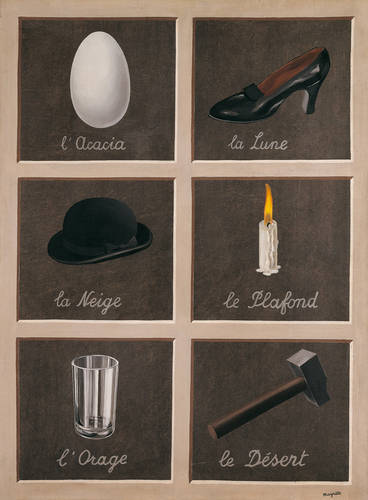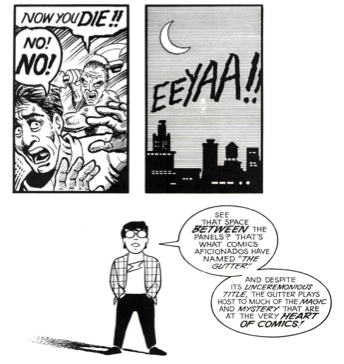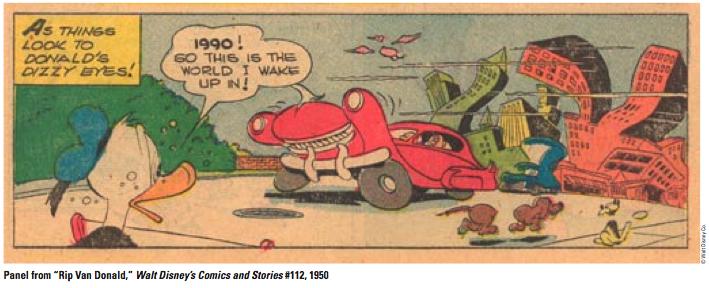“Closure” is a cognitive prerequisite for reading comics, as explained by Scott McCloud – but this holds also true for all media and the cultural medium. It may be also valuable for your project approaches, for the ‘space of (re)action’ you try to construct for your passersbys, pupils or family members to (re)act in, where they are free to generate new meaning.
Some connections to former concepts we disucssed:
Foerster’s “Blind Spot”: Obviously we do not see that there are blind spots. The neurophysiological blind spot in our field of vision gets ‘stitched shut’ by our brain, so we have no gaps in our world(view). Generating continuity where there is none is an effect of closure.
Bateson’s “Context and context markers”: No situation is exactly as any one we encountered before. We need generalized context markers that let us decide upon a current context in a situation. A ‘room’ with ‘rows’ of ‘tables’ and ‘seats’, all ‘aligned’ and ‘directed towards’ a kind of ‘presentational medium’ – and we ‘see’ a classroom-context, with closure smoothing over anything that is situational or does not exactly fit into this picture.
Arts and media: See the examples below by Rene Magritte and Scott McCloud.
Education and didactics: By softening, recontextualising or sabotaging context markers, we may become aware of them as cognitive constructs: generating a big, continous picture will then turn into a willing, conscious act of (inventive) closure (McCloud may call this “Non-Sequitur”; though there may be a medial step-up). The awareness may be a temporary dip into a higher type of learning.
Exposing closure: Lateral thinking questions
A fun way to train lateral thinking (“thinking outside the box”) are questions of the following ilk, where our usual mechanisms of “closing” a mental image, based upon just a few facts, leads us astray:
“(…) Sometimes a problem seems difficult or insoluble because our assumptions about it are wrong.
A classic example: A father and his son are involved in a car accident, as a result of which the son is rushed to hospital for emergency surgery. The surgeon looks at him and says “I can’t operate on him, he’s my son”. Explain.
A variant of this involves a father and son travelling on a scheduled flight; the father asks the flight attendant if his son may visit the cockpit and she takes him there. When he’s gone the pilot explains to the co-pilot “That was my son”. For a few people there’s no ‘puzzle’ here, but most of us are so used to seeing only male surgeons and pilots that we too easily overlook the obvious explanation: the pilot or surgeon is the boy’s mother.”
(quoted from eluzions.com, Jun 14th 2012)
Try this story with kindergarten-teacher, a dancer, or a hairdresser and see if the results are the same (this kind of deceptive gender stereotyping can also be measured by an implicit association test).
Have another story, a bit more complicated:
“In a room with an open eastern window and a southern breeze blowing through the south eastern orchids, near the scenic view of a european country, lyes the bodies of Romeo and Juliet. Two lovers that have died. Their bodies are near a table and surrounded by a pool of water. How did they die?”
Do you have a mental image in your mind after reading this text?
This is the helpful, but also sometimes restricting effect of closure.
We are closed/open
One of the best books (or medium) to explain comics, is Scott McCloud’s comic “Understanding Comcis”. The title is a hommage to McLuhan’s “Understanding Media”, written three decades before. McCloud not only explains comics, but also aspects inherent to all media and human cognition, aspects like closure or amplification by simplification.
Famous game designers like Chris Crawford and Will Wright (“The Sims”) recommend McCloud’s comic. How come?
“Our industry-culture has raised visual verisimilitude to the status of a stairway to heaven; McCloud’s points might help bring us down to earth. He presents a sequence of decreasingly detailed renditions of a human face. At the left end of the sequence is a photorealistic representation; at the right end is a circle with two dots for eyes and a line for a mouth. “By stripping down an image to its essential ’meaning’, an artist can amplify that meaning in a way that realistic art can’t. … The more cartoony a face is, for instance, the more people it could be said to describe.” ”
– Chris Crawford (1993-93), “Book Review: Understanding Comics”
(Compare also to Will Wright’s simplified language “Simlish”.)
With other words: The artist, educator, therapist creates the demarkation for a nearly ’empty’ medial space – for you to fill with individual meaning!
Creating a space for you!
If we talk, there’s magic happening. A sequence of sounds – or letters – become words, and evoke meaning. By saying “egg”, “huevo”, “Muna” or “Ei”, a concept of a white, ovoid form comes to our minds, without there being a necessary connection between the sequence of sounds and its denotation. Where is this connection coming from?
But there’s even more potential magic to discover:

René Magritte (1930): “The Key to Dreams”.

Scott McCloud (1993), “Understanding Comics”, p. 72
“See that space between the panels?” – What about the space between words and images, between the lines of the image, or between the words? Do you see these spaces?
That, what you do not see, is a medium at work: Creating a space for you.
Transfering ideas to a medium, or even a try to represent reality in a medium, requires the artist, edcuator, propagandist to leave out a medium-specific ‘gutter’, where the reader, viewer or learner fill in the gap (e.g. words in a text are not ‘connected’; a camera never shows the place behind the objective; a painting ‘stops’ at its frame).
“You do not see what you do not see.” (Heinz von Foerster) – This is the power of a medium, and the responsibility of an educator, designer or artist: working with and within a blind spot of medial reception, for the learner to discover, and play with.
Task:
What is “closure” (McCloud 1993, “Chapter Three. Blood in the Gutter”)?
There seem to be different kinds of closure, based on the physiological limits of our senses to the limits of our (culturally affected) cognition.
“In electronic media, closure is constant, even overpowering!”
– Scott McCloud (1993), p.65
Can this phenomenon of medium design and medium usage be found in other media as well? How can closure be used in learning/teaching?
For a take on closure as predominant in electronic media, see e.g. also “Database as symbolic form” in Lev Manovich (2001), “The Language of New Media.” Cambridge: MIT Press, 2001. [X]
“After the novel, and subsequently cinema privileged narrative as the key form of cultural expression of the modern age, the computer age introduces its correlate – database. Many new media objects do not tell stories; they don’t have beginning or end; in fact, they don’t have any development, thematically, formally or otherwise which would organize their elements into a sequence. Instead, they are collections of individual items, where every item has the same significance as any other.”
– Lev Manovich (2001), “The Language of New Media”, p.194






 (moss invader)
(moss invader)